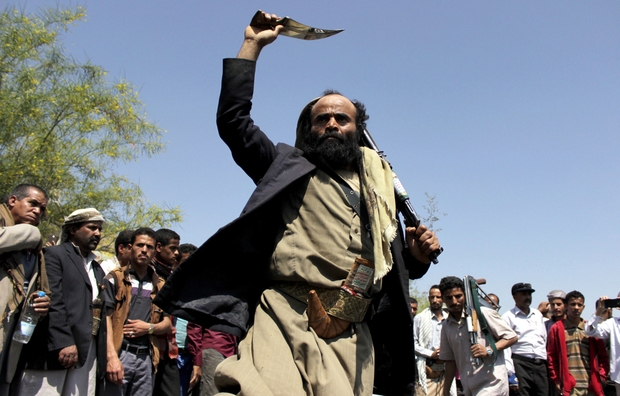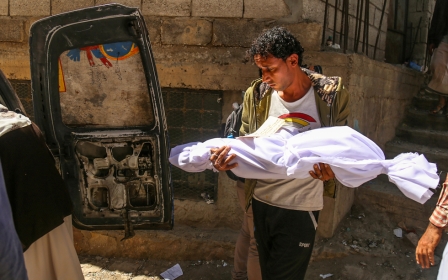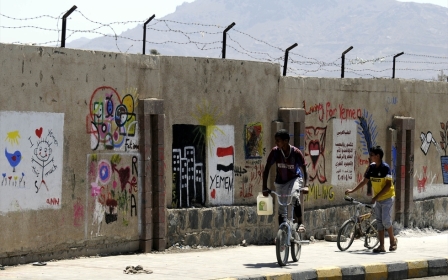The Houthis are ensuring that Yemeni civilian deaths result from Saudi-led airstrikes

It is as if the Houthi militiamen and allies occupying Yemen’s capital, Sanaa, are happy with the mounting civilian casualties resulting from Saudi-led coalition airstrikes on the country - even though these strikes aim at restoring the power base of the rebels’ enemy, President Abd Rabbuh Hadi.
The Houthi rebels and their allies from the camp of deposed president Ali Abdullah Saleh seem happy because they are using the smoke-screen of international criticism of Saudi Arabia to establish weapons stores, human shields and military headquarters in civilian infrastructure such as schools and hospitals.
The strikes, which began in March 2015, just six months after the Houthi militia took the capital, had started following reports of spiralling human-rights abuses by the rebels and their allies in the city. Anger had grown among Yemeni civilians who were not happy with rebel-led “coup” that saw Hadi captured and forced to resign before he escaped and rescinded his resignation.
Houthi-Saleh militiamen have committed heinous crimes in violation of international humanitarian law since the occupation of Sanaa and other regions. The rebels have not only targeted civilians, but also used human shields in schools and hospitals.
In a report released by Human Rights Watch in January, the group slammed the Houthi forces placing militia in a school for the blind in Sanaa, saying this placed vulnerable children “at grave risk”.
"The Houthis have based armed men near a school for blind students, showing obvious disregard for the lives of some of the most at-risk civilians," wrote Shantha Rau Barriga, HRW's disability rights director.
UN investigators have also found that the Houthi militia are using African migrants as human shields. This is not a first for the rebels, according to a previous accusation also from the UN in 2009.
"Houthi-Saleh forces more than once housed African migrants and refugees as human shields in unused buildings in Aden previously targeted by air strikes, or where weapons caches were claimed to be stored," wrote the UN investigators in their 2016 report.
The report also found that the Houthi-Saleh alliance has been largely financed by seized state assets, new taxes, and extortion.
The Saudi-led coalition is rightly criticised by human rights groups, but the Houthi militia seem to have escaped wider international criticism for their role in ensuring that civilians die in the Saudi air strikes.
At the same time, the rebels are also benefiting from a media backlash against the Saudi destruction of Yemeni infrastructure.
The Houthi-pro-Saleh militias are storing weapons in public buildings such as schools and hospitals, and then also using these premises as military headquarters.
There is little mention in the media that the Houthis themselves are ensuring that such facilities are targeted by turning them into military sites. There is even less media attention on the civilian infrastructure that that the Houthi-Saleh destroy.
Houthi-Saleh forces have also forcibly recruited and trafficked third-country nationals, many of whom are trafficked minors, according to UN investigators.
"Migrants and refugees have accordingly been viewed as fighters or potential fighters, irrespective of their civilian status or vulnerable status as trafficking victims, and come under attack," they added.
Children and journalists have been used as human shields by the Houthis. Earlier this year, the press freedom organisation Reporters Without Borders classified the Houthis as the second-largest hostage-takers of professional journalists, only one behind the so-called Islamic State (IS).
This is perhaps ironic because previously while there was no trace of IS in Yemen, the group has apparently been able take root and grow under the Houthi occupation, launching its first attacks on the country in March 2015 with deadly suicide bombings at a mosque. Another sadly ironic fact is that in 2009, then president Saleh accused the Houthis militia of using civilians as human shields. Today, he appears to have joined them.
Troubled Taiz
In Taiz, a city in the Yemeni Highlands which has been under a suffocating siege for almost a year, Houthi and Saleh militias have used similar tactics.
In the areas which have come under their control, the rebels have turned schools, universities and government facilities into weapons stores and military headquarters. The militias will use troops and tanks deployed in schools and university courtyards to attack residential neighbourhoods, often breaking into the homes of civilians and capturing them to use as human shields.
This tactic complicates any resistance towards the rebel’s occupation of the city, with opposition fighters well aware that assaults on the infrastructure could results in the death of civilians.
Using the presence of civilians to protect armed militias is a war crime, which demands a referral of the leaders involved to international justice. It is an obvious violation of the rules of international humanitarian law and all human rights charters.
Yet we have not seen any clear international condemnation over the suffering being inflicted on the civilians in Yemen in general, and Taiz specifically, through this practice.
Houthi and Saleh militias have also refused to allow humanitarian aid (food, medicine and oxygen cylinders) to enter Taiz city, without seeing any denunciation or serious movement by international human rights organisations.
In addition, Houthi militias in some areas used kidnapping and forced disappearances, sometimes as a means to extort money, where families are required to pay money in order to release their abducted sons or even just to know their fate.
As human-rights activists, our responsibility is not only to document such violations, but also to bring these cases to international courts. The world must address the situation of those being kidnapped and forced into harm’s way by the Houthi and pro-Saleh armed group.
- Basem Alabsi is a Yemeni human rights activist. You can follow him on Twitter @BasemAlabsi
The views expressed in this article belong to the author and do not necessarily reflect the editorial policy of Middle East Eye.
Photo: Supporters of the Houthi militia in the Yemeni city of Taiz on 1 April, 2015 (AFP).
Middle East Eye propose une couverture et une analyse indépendantes et incomparables du Moyen-Orient, de l’Afrique du Nord et d’autres régions du monde. Pour en savoir plus sur la reprise de ce contenu et les frais qui s’appliquent, veuillez remplir ce formulaire [en anglais]. Pour en savoir plus sur MEE, cliquez ici [en anglais].





